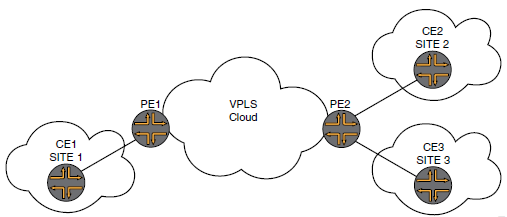Answer
The following illustration shows a sample topology used to answer this question:

A PE router has several site IDs configured within the same VPLS instance. The PE router advertises a separate label block for each of these site IDs to the remote PE routers. The label block associated with the lowest site ID number is selected to build pseudowires between the local PE router and the remote PE routers. You can use the show vpls connections command to verify that the pseudowire that has "Up" status between two PE routers is associated with the lowest site IDs on both PE routers.
Router PE1 derives its labels from the label block associated with Site 2, which comes through Router PE2.
If Site 2 goes down and Site 3 remains operational, Router PE1 changes its label allocation to use the label block associated with Site 3. Consequently, a failure of Site 2 causes a loss of traffic between Site 1 and Site 3.
Additionally, traffic disruption can occur if Site 3 is provisioned initially, and Site 2 is provisioned at a later time. When Site 2 comes up, this causes a change in the labels used by Router PE1 for both Sites 2 and 3, causing traffic disruption for Site 3.
Solution: Router PE1 only programs its forwarding table to push labels that are advertised by a Site 2 label block. The forwarding table for Router PE2 expects traffic to come with the label advertised in a Site 2 label block. Neither Router PE1 nor Router PE2 has programmed their forwarding tables to use labels from a Site 3 label block, consequently, there will be traffic loss if Site 2 goes down. Traffic will resume after Router PE1 and Router PE2 program their forwarding tables to use labels from a Site 3 label block.
This is the intended behavior and is working as designed.
In Junos OS 10.0 and later, use the label-block-size size statement to configure VPLS label block size. Use this to increase the VPLS scaling. If the label block is configured as two, this will increase the VPLS scaling four times. You can allocate the label block size in increments of 2, 4, 8, or 16.
For more information, click VPLS Label Blocks Operation.